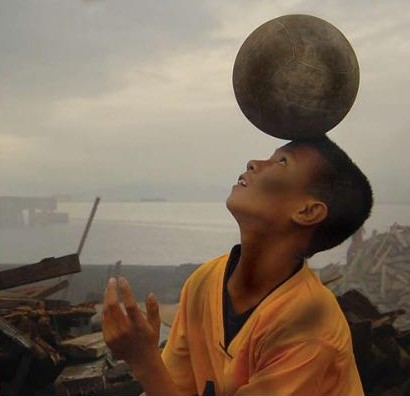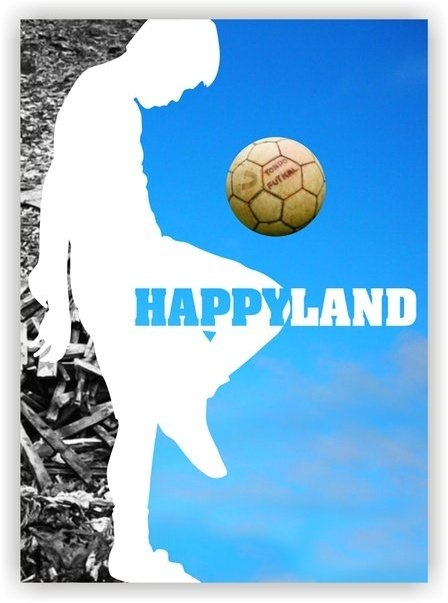In a earlier post, I wrote about the circumstances behind my joining the Happyland team as one of its producers. Here is the second part of my experience as an indie movie producer.
The Main Story:
Jim conducted various interviews with football aficionados, Don Bosco Brothers and former Tondo barefoot players to weave the story for the film. This is the excerpt of the movie:.
A Spanish missionary priest tries to form a fighting football team composed of disadvantaged boys from the slums. He enrolled the help of a seminarian, who was a college football star; his assistant parish priest; a volunteer catechist, and, parish workers.
Together, they recruit the most unlikely group of young men – a neighborhood basketball star; a skilled pickpocket and fearless thief; two drug-sniffing brothers who live off the garbage dump; a hare-lipped rapper wannabe; a gang leader; a pedicab driver; and many others. The young men were lured by the dream of winning the tournament’s hefty cash prize. And to win, they only have to do one thing — beat their opponents from the “rich catholic schools.”
The priests, the seminarian, catechists and other church people set out to build his football team.
The Back Story
The priest was inspired by the story of Filipino striker Paulino Alcantara – star of the Spanish football team FC Barcelona in the 1930s. His record of 357 goals in 367 games is still unmatched in Spain’s football history. It is the memory of Alcantara’s feats that inspired Father Jose, the Spanish missionary priest, to attempt the audacious: build a football team in the slums of Tondo.
Our original plan was to shoot some scenes in Barcelona to highlight the extraordinary feat of Paulino Alcantara. Budgetary constraints prevented us from doing so. Thus,we settled for dream scene instead. However, the Paulino Alcantara story may have been among the reasons (plus probably the fact that Spain won the FIFA World Cup that year) why we got invited to screen the film during the Spanish film festival in Manila in 2010.
The Actors
Strictly speaking, we did not have any professional actors in the cast. But we do have football players who had important roles in the movies: Phil Younghusband, China Cojuangco, and football players from various exclusive schools. We also hired actual residents as extras. Some of the supporting characters were playing their real selves. Nevertheless, the production experience was one of camaraderie and fun.
People behind the Camera
Mitch Moreno, Jim’s partner, was the project’s workhorse. She was in control of all aspects of the project, except the creative side which was Jim’s.
I helped raised money from corporate sponsors. Initially the corporate guys listened to the pitches mainly because they were my friends, but when they started to interact with the production and the creative group, and after they have internalized the film’s story line, they become converts. We got funding from Alaska, Rebisco, and a few other brands..
Butch Jimenez and Manny Luna of Activ Asia pitched in with their personal funds. It was Mitch and Jim who talked to Butch and Manny, and since I saw the presentation outline before the meetings, I believe they were not there as financial investors but as believers in the objectives of the project.
We also got grants from a European donor and from the Film Development Council of the Philippines (FDCP). We also did crowd-sourcing, a way of raising money via the social network, and got monetary contributions from various individuals.
It was a lean and mean way of running a movie production project, poles apart from my experience with my former network. At Happyland, we planned every shooting day and source out the best cost for everything we need in the production. It also helped that some members of the creative team agreed to cuts in their professional fees..
The Setting:

The movie’s setting was a place in Tondo that residents call “Happyland,” which comes from the word “hapilan” — a Visayan word for “garbage dump. “ The movies main characters lived in this place – a former smoking mountain of trash that government bulldozers levelled to give way to substandard and cramped residential buildings for the poor.
At one point, Star Cinema talked to us about the possibility of co-producing the film. It came with a condition though. They will re-write portions of the story to make it more commercial, introducing among others, a love angle aspect to the story. A tie-up with Star Cinema would have meant a great boost to the commercial success of the film. On the other hand, it would also mean we have to replace a number of actors, which would have resulted in a dissension among the ranks of our technical and creative personnel. A number of them are apprehensive with working with a major studio as this may result in loss of their creative independence. After much thought. I politely told Malou Santos, MD of Star Cinema, that in the interest of “industrial peace” I will have to refuse her offer.
The Economics
We struggled to finish the film. We began filming at the beginning of 2010. We intended to release the film around June or July 2010, around the same time as the World Cup. However, problems encountered during post-production delayed the film’s release and put the production into debt. The post production house has inadvertently erased very important materials from two days of shoot, so we have to re-shoot those scenes. Production costs also shoot up because of the elevated cost of storage and expensive cost of post production that the choice of Red Cameras entails.
Nevertheless, there were opportunities that resulted out of our failure to meet the June-July 2010 deadline. Spain won the World Cup, and so when they held their Spanish film festival in Metro Manila in October 2010, they look for a football movie to show in their festival. Happyland is that movie – the first movie about football produced by a Filipino team.
Next Steps
The first payback we got was that we were able to provide opportunities for personal growth to the more than 20 teenaged football players who joined the cast. Some of the boys got football scholarships. Another one became a team member of the Philippine team to the Homeless World Cup. Moreover, the boys today are more confident and sure of themselves compared to how they were before we started their training.
Meanwhile, the Philippine football team -the Azkals, won games in the Asian stage and soon enough, football became a household word. That rubbed off on us, and it became a bit easier to get groups and communities to sponsor private screenings of the movie. Adobo magazine – the authoritative advertising industry publication sponsored a special screenings of the movie. It even got its corporate clients and guest to donate money or shoes for the Tondo boys.
It was clear to us that Happyland will have a difficult time at the commercial theaters, so our strategy was to do private screenings of the movie. It was also screened in various Sineng Pambansa events in various cities around the country. And it is making the rounds in schools and communities.
To be sure, we are still a long way from recovering the investments we made for the movie, But it is an historical first. It is the first football movie produced in the Philippines. It even won awards for some of our creative and technical staff.
And to me, the satisfaction of being part of a pioneering media vehicle featuring the game of football.
Below is the full trailer of the movie.
[youtube_sc url=”http://www.youtube.com/watch?v=E0gulakzYMU”]



